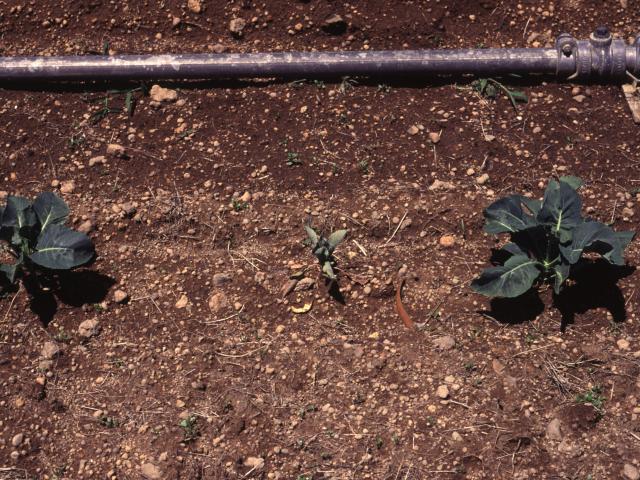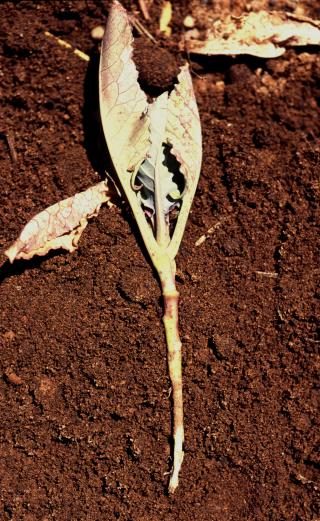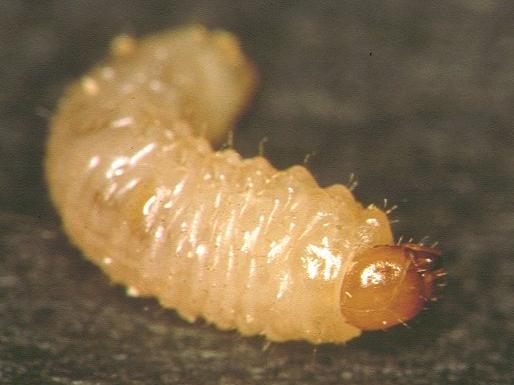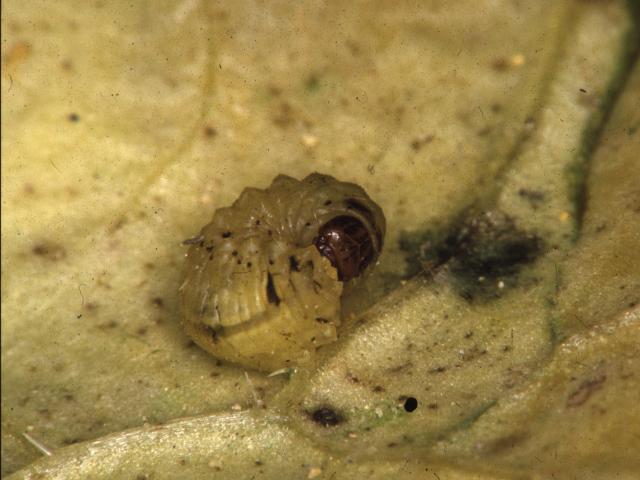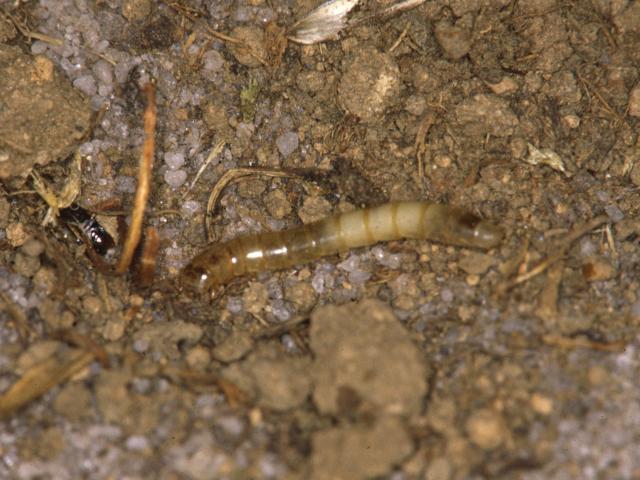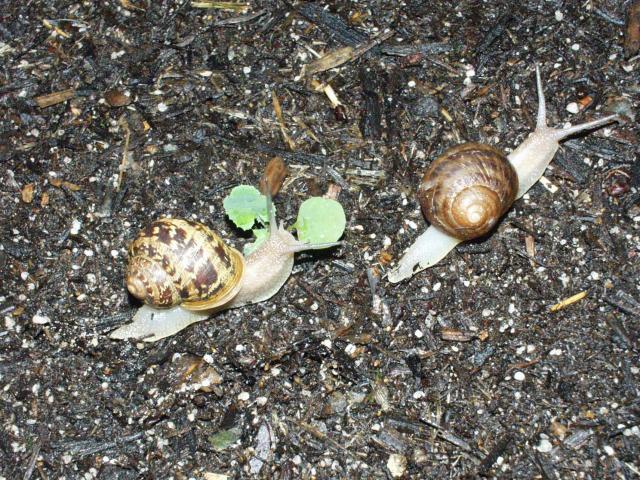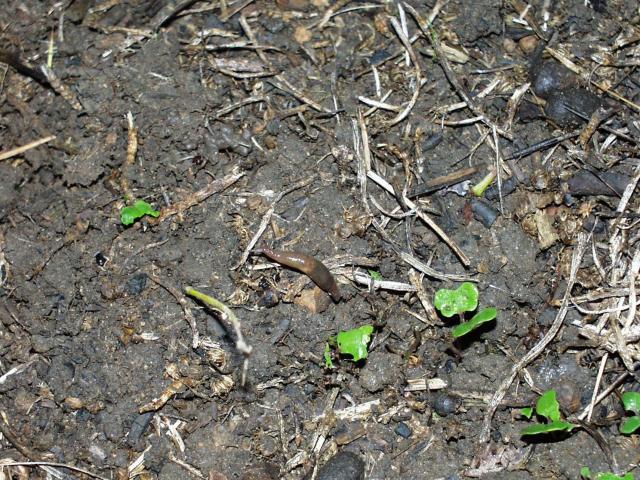Insects affecting crop establishment
Establishment pests include many beetle adults and larvae which occur principlally in the South, molluscs (common garden snail and slugs) and larvae of cutworm moths. The damage occurs as below-ground root pruning and/or stem girdling, resulting in the death of seedlings. Leaf feeding can also cause damage and retard plant growth, which may be severe enough to kill seedlings.
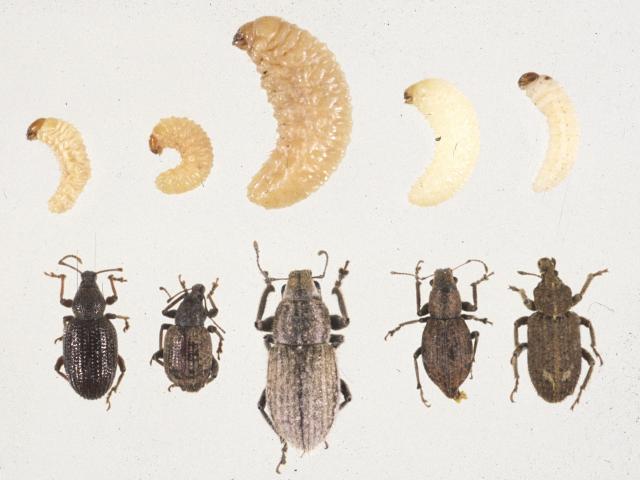
The range of weevil pests in both adult and larval stages that can affect crop establishment is shown in the photo above. From left to right they are the apple weevil which can be important, garden weevil which is a minor pest, whitefringed weevil which can be important, Fuller's rose weevil which is a minor pest and vegetable weevil which can be important. Note that we cannot readily distinguish between the brown headed larvae of apple weevil and garden weevil, and the early stages of the white headed weevil larvae whitefringed weevil and Fuller's rose weevil.
Apple weevil (South)
Apple weevil grubs grow to about 10mm long, do not have legs, live in the soil and have a brown head capsule. They kill seedlings and young transplants by chewing through the stem below ground.
Before seeding or transplanting assess their abundance by examining 50 to 100 square spade soil samples on a grid pattern across the area in which the crop will be grown. There is no established threshold, but it is probably worth taking some action if 5 to 10% of samples have larvae. These larvae are similar in appearance to garden weevil, which has not been reported to be a pest to date.
Apple weevil adults are dark brown (see photo of adults and larvae above), about 8mm long and nocturnal. All adults are female and do not fly. They survive well in pastures in the South-West.
During the day, they burrow into the upper soil layer. They damage seedlings and young transplants by feeding on leaves, the growing tip or ringbarking the main stem. Dig around the base of a damaged plant to assess the abundance of burrowing adults. If crop damage cannot be associated with any pest seen during the day, check for weevils feeding on plants at night.
Whitefringed weevil (South)
Whitefringed weevil larvae (see photo of adults and larvae above) do not have legs, live in the soil and have a white head capsule. They grow to about 15mm long.
They kill seedlings and young transplants by chewing through the stem below ground. Assess their abundance in the same manner as for apple weevil larvae, using the same threshold for action.
Adults are grey with a pale or white stripe down each side and are about 15mm long (see photo of adults and larvae above). All adults are female and do not fly. They may feed on the leaves of brassica crops, but are not a major pest. Adults are active day and night.
Vegetable weevil
Vegetable weevil larvae do not have legs, range from cream to green and grow to about 15mm long (Figure 5). They have a dark brown/black head capsule and a brown plate across the top of the thorax, just behind the head. These larvae, which feed at night, can damage leaves. Dig around the base of damaged plants during the day to find larvae just below the soil surface.
Adults are grey with two diagonal bands near the tip of the abdomen (see photo of adults and larvae above). The weevils are about 10mm long, feed at night and damage leaves.
Check for these weevils by looking around the base of the plant by day or at night when the adults may be seen feeding on the plants.
Small lucerne weevil (South)
Small lucerne weevil adults are grey and similar in shape to whitefringed weevil adults, but are only about 8mm long. All adults are female and do not fly. They damage seedlings and young transplants by leaf and stem feeding.
Monitor for these pests during the early stages of crop establishment where plant damage is noticed. Adults are active day and night.
Spotted vegetable weevil (South)

Larvae of spotted vegetable weevil are legless, have a brown head capsule and can be distinguished from larvae of apple weevil and garden weevil by the presence of a breathing pore under each lateral abdominal spine. This pore may be seen using a ten times hand lens or microscope.
These soil borne larvae can be very abundant and may be mistaken for other more important soil pests. The pest status of vegetable weevil larvae is thought to be minor.
Spotted vegetable weevil adults are speckled grey/black and about 5mm long. They damage brassica crops by feeding on leaves and stems of young plants. When damage is noticed, look for these pests at the base of the plant during the early stages of crop establishment. Adults are active day and night.
Vegetable beetle (South)
Vegetable beetle larvae or false wireworm have three pairs of legs on the thorax. They are long, thin, shiny, hard-skinned and live in the soil, although may be found just under surface organic matter. They may damage seedlings or young transplants by feeding on the stem, but are not usually a pest.
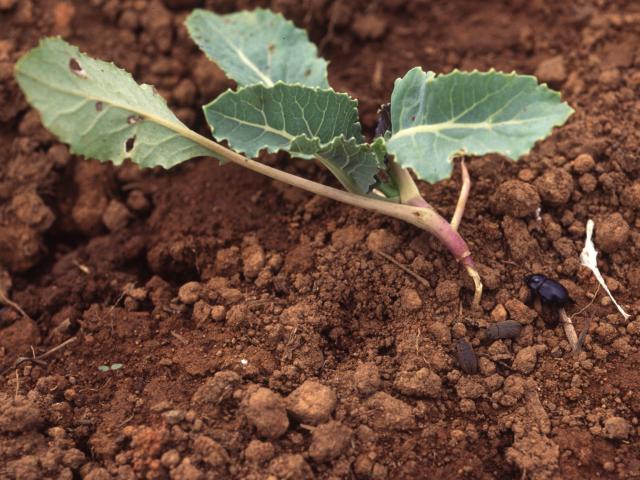
Adults are hard-shelled, slightly flat, ground-dwelling beetles about 10mm long, which can fly. During the day they may be feeding or resting under clods of soil or rocks, or under organic matter. They can kill or retard plant growth by feeding on leaves and stems of transplanted or recently emerged seedlings.
African black beetle (South)
African black beetle adults (see photo above) are shiny black, hard-shelled beetles about 10–15mm long. They live in soil but also crawl on the soil surface. They can fly and often undertake mass dispersal flights, sometimes in spring but more commonly in late March and April. They can kill seedlings and young transplanted plants by feeding on the stem at or just below ground level.
Snails and slugs
Common garden snails and slugsfeed on leaves of young plants, retarding growth. But they are more important because they feed on the harvested portion of the crop (head or curd) rendering it unfit for sale. Monitor before planting by an even placement of mounds of crushed grain, cereal bran or snail/slug bait across the crop area.
Cutworm
Cutworm grubs are soft-bodied moth larvae, with variable colour from pink to grey to black. They have three pairs of legs on the thorax.
They kill young plants by feeding on the stem at or just below ground level. Check for these grubs by digging around the base of damaged plants during the day or check for grubs feeding at night.

